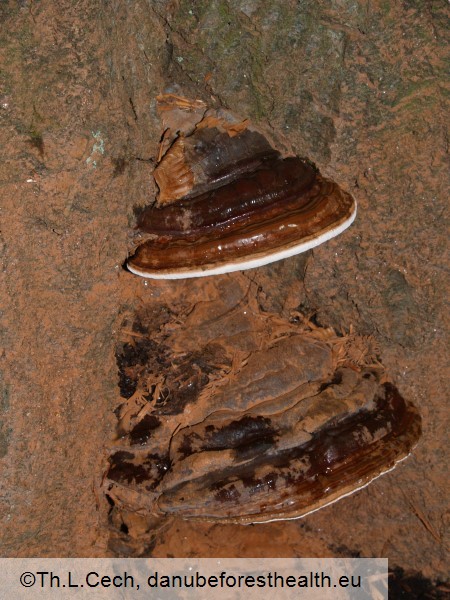Fungi
Ganoderma
Ganoderma spp.
Thomas Cech
|
|

Fig. 1. Ganoderma adspersum. Fruiting bodies covered by bright brown spore masses.

Fig. 2. Ganoderma applanatum. Fruiting bodies with galls of the fly Agatomyia wankowiczii on the fertile lower surface.

Fig. 3. Ganoderma applanatum. Young glossy fruiting bodies with white rim.
DETECTION PERIOD:
All seasons, new fruiting bodies mostly June to October.
DESCRIPTION:
Ganoderma species produce typical perennial or more rarely annual (G. resinaceum) hard and big brackets with brown spore powder and with a characteristic dark brown glossy surface (Fig.3) and dark inner tissues. The upper surface shows various shades of brown or reddish, sometimes it is covered by brown spore dust (Fig.1,3). The rim of the bracket is usually lighter. The lower surface (fertile layer) consists of lighter pores, which are dense and roundish. Some species are pedunculate (G. lucidum), most of the species however are sessile.
HABITAT:
Ganoderma species occur worldwide. Some species (eg. G. adspersum) are rather thermophilic, their fruiting bodies need warm and humid conditions to develop. In Central Europe some species are related to synantropic habitats (parks and public gardens, alleys, cemeteries), however they also can be found in all kinds of forests.
STATUS:
Ganoderma is widespread in Europe, but rarely of epidemic spread. The species are saprophytic and parasitic, usually entering trees via wounds and often following Phytophthora as secondary agents.
IMPACT:
Ganoderma species cause a white rot of stem and roots, may lead to breakage of trees.
SIMILAR SPECIES:
Other bracket fungi can be mistaken for Ganoderma, however their fruiting bodies are mostly not glossy and not brown-red.
|